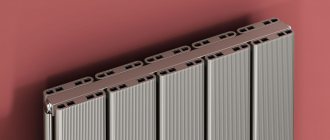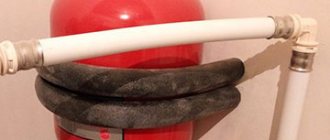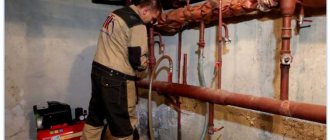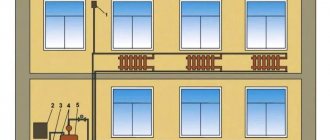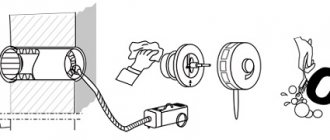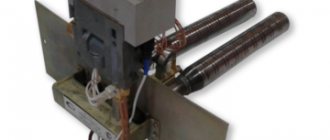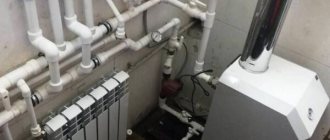Date: April 8, 2014 During normal operation of pipelines, the direction of water flow is assumed to be in one direction.
To prevent the formation of backflow, check valves are used that have a one-way flow capacity and operate automatically.
Check valves are used when several pumps operate when combined into one network.
When the pressure in one line decreases, excess water pressure forms a reverse flow in it, which can cause damage to the pump and fittings.
The check valve automatically cuts off the emergency section from the reverse flow.
When choosing a check valve, its main technical characteristics are taken into account:
- Bore diameter DN (nominal diameter). A number of conditional passages are prescribed in GOST 28338-89;
- Pressure PN (nominal pressure) is the maximum excess pressure at which long-term and safe operation is guaranteed. A number of nominal pressures are prescribed in GOST 26349-84.
- In addition to domestic standards, international ISO, North American ANSI, and German DIN are used.
Three way heating valve
Typically, boiler automation cannot meet the need for water at different temperatures for several circuits of the heating system. A three-way thermostatic mixing valve of the heating system comes to the rescue, which maintains the necessary thermal parameters of the coolant in the circuits of the heating system, as well as in the small circuit of the system. The valve looks like a simple tee, the metal is bronze or brass. An adjusting washer is installed at the top of this tee, under which there is material sensitive to temperature changes. And if necessary, it presses on the working rod coming out of the housing. The main task of the valve is based on maintaining the temperature of the coolant at the outlet within specified limits by adding cold or hot water . During unsuitable temperature changes, the external valve actuator presses on the stem. Next, the cone leaves the saddle and a passage opens between all channels. During operation, the three-way valve is controlled according to temperature by an external actuator.
Purpose and range of shut-off valves
For heat supply systems, this fitting is used to control the supply of hot coolant and open the heating circuit.
As a rule, a shut-off valve on a heating device is mounted in areas where radiators are piped. In addition to functional advantages, such a solution has practical benefits. After closing the shut-off valve of the battery, the home craftsman will have the opportunity to repair it without stopping the functioning of the entire heating structure.
Today, shut-off valves for heating are offered in a wide range on the domestic market, and among the most commonly used products are the following devices:
- shut-off valves;
- valves;
- needle valves;
- Ball Valves.
Heating check valve
A complex heating system contains a fairly large number of auxiliary elements, the task of which is to ensure reliability and uninterrupted operation. One of these elements is the heating system check valve. A check valve is installed to prevent flow in the opposite direction . Its elements have very high hydraulic resistance. Due to this circumstance, there are restrictions on the use of check valves in a heating system with natural circulation. There is too little pressure in such a system. At minimum pressure, it is necessary to install gravity valves with a butterfly valve; some of them can operate at a pressure of 0.001 bar. The main part of the check valve is the spring, used in almost all models. It is the spring that closes the shutter when normal parameters change. This is the principle of operation of a check valve.
It is necessary to take into account the operating parameters in a particular heating system. Therefore, select a heating system valve that has the required spring elasticity. Shut-off valves used in heating systems are usually made of the following materials: steel; brass; stainless steel; gray cast iron. Check valves are divided into the following types: disc valves; petal; ball; bivalve. These types of valves are distinguished by a locking device.
Kinds
In the construction of industrial and domestic pipelines, various types of shut-off valves are used. The choice of check valves on the modern market is quite large, and 5 types of equipment are most often used.
- The disc shut-off valve is a compact device, the smallest in the family. Operating principle: as the pressure increases, the disk, which normally closes the working current channel, opens, setting the direction of movement. As soon as the pressure decreases, the disk springs back into place.
- The ball device has a slightly different design than the disk one. Here, a ball is used as a closing element: under the influence of the flow, it rises, opening the channel, and when the pressure is released, it returns to its original position, blocking the flow. This type of check valve is good because it can be installed in systems with different diameters of overpass pipes.
- Petal. From the name it is clear that its design contains rigid petals - they move apart, driven by the flow, and when a reverse current occurs, they close, hermetically blocking the movement.
- Lifting shut-off valves are a type of check valve equipped with a shut-off spool cup. The principle of operation is the same: under the influence, the spool rises, and when it decreases, it returns to its original position. The choice of a lift-type check valve is justified only if it can be installed horizontally.
- The 2-blade shut-off valve is a large-sized unit that can withstand high pressure in the event of a breakdown of pumping equipment. The choice of a check valve of this type is logical for complex water supply systems in which there is a high probability of pump failures and severe impacts. Shut-off valves are often used in autonomous water supply systems of private houses, where the water flow is pumped by powerful pumps. The principle of operation of a two-bladed device: with sufficient pressure, the closing element is folded in half, the appearance of reverse current leads to its return to its original state.
Heating control (shut-off and control) valves
Regulating and shut-off and control heating valves systematically change the flow of coolant, from maximum to minimum , with the valve open and closed. Shut-off or shut-off valves control the coolant discretely when the valve is in the fully open or fully closed position. A control valve consists of three main blocks: the body, the throttle assembly, and the valve actuator. The closing and regulating element of the valve is the throttle assembly. When choosing a sleeve, seat, or plunger, you should pay attention to the operating conditions of the valve. The medium and its temperature, the presence of impurities, and throughput are taken into account. The main and important importance in the operation of the valve is the correct direction of supply of the working medium. It is usually marked with an arrow on the working surface of the case.
Installation and configuration rules
The valve must be installed in the direction of the main current; for this there is an arrow on the body. The joints are sealed using paronite, but the gasket is placed so that the internal diameter of the passage device does not decrease. The condition is important to prevent water hammer in the pipeline network.
The device is installed so that other elements of the highway do not affect its operation. The section of pipe containing the valve may be supported by a metal frame to prevent vibration or other disturbances. A mesh is placed in front of the passage mechanism for rough cleaning of solid impurities.
Thermostatic valve
In modern realities, a thermostatic valve is a prerequisite for modern and reliable equipment in a heating system. The valve temperature is automatically adjusted. The operation of a heating system mixing valve for radiators is to limit the supply level to an individual heating radiator. The valve stem makes movements to open and close the hole. Through this hole, coolant enters the radiator. When the valve with a thermostatic head heats up, the inlet opening is closed, as a result of which the coolant flow rate decreases. The thermostatic valve constantly changes its position. And an important factor is the quality of the materials on which this product is made. The product may fail due to sticking of the rod, as well as significant corrosion and breakthrough of sealing materials. But even if the thermostatic valve fails, you can extend its service life by replacing the thermostatic element.
Heating system valves with thermal heads differ depending on the shape and type of supply to the heating system. They can be angular when connected to radiators from the floor, or they can be straight, which connect the pipes to the battery relative to the wall surface. Axial, mainly when connecting pipes from the wall to the battery. When connecting batteries sideways, a special kit is required. It uses thermostatic heads and valves. Batteries that come with a bottom connection are obviously equipped with valve-type inserts.
Pressure regulator
The operation of the batteries and the pump is disrupted due to high or low pressure levels. Correct control of the heating system will help to avoid this negative factor. The pressure in the system plays a significant role, it ensures that water gets into the pipes and radiators. Heat loss will be reduced if the pressure is standard and maintained. This is where water pressure regulators come to the rescue. Their mission is primarily to protect the system from too much pressure . The operating principle of this device is based on the fact that the heating system valve located in the regulator works as a force equalizer. Depending on the type of pressure, regulators are classified into: statistical, dynamic. It is necessary to select a pressure regulator based on throughput. This is the ability to pass the required volume of coolant, in the presence of the required constant pressure drop.
General information and areas of application
Purpose
The pipeline system provides for constant movement of the medium in strictly one direction. When the pressure decreases, backflow may occur, which can cause damage and damage technical equipment.
A check valve is a pipeline shut-off device that does not allow the flow of the working medium to pass in the opposite direction.
In the event of an emergency, it acts as a fuse to protect the pipeline or equipment from critical changes or hydraulic shocks. Operation occurs automatically due to the energy of the water flow, which classifies the device as a direct-acting valve.
Areas of application
1. Centralized water supply.
2. Autonomous water supply.
3. Sewer line.
4. Autonomous heating.
5. Industrial networks:
- water pipes;
- drains;
- oil and gas pipelines;
- transportation of chemicals;
- other engineering networks.
Problems to be solved:
- preventing cold water from entering a hot pipe;
- system pressure stabilization;
- protection of pumping equipment when the pump stops;
- protection of equipment from water hammer;
- leakage prevention;
- preservation of pipe filling.
Advantages
The manufactured products have a carefully thought-out design with high efficiency.
Advantages:
- stable operation under sudden pressure changes;
- minimum flow closure time due to the small stroke of the shut-off device;
- automatic action when the flow or system parameters change;
- small weight and size values;
- versatility;
- simplicity of design;
- ease of maintenance;
- good throughput;
- the use of different technologies for fastening to pipes.
Heating bypass valve
To relieve the working medium, use the bypass valve of the heating system thermostat, which operates in the return direction when the pressure increases significantly . As a rule, the pressure increases due to the achievement of the maximum temperature set manually, the supply of coolant to the radiator decreases, as a result of which the pressure increases. Heating system bypass valves are basically designed to ensure a stable difference between the return and supply pipes. When the heat load decreases, the thermostatic valves close, resulting in a pressure difference between the pipelines. As a result of using a bypass valve, the load on the pump is reduced, the return temperature increases, and the boiler is protected from corrosion. The scope of application of the heating system bypass valve is quite wide; it is also used to prevent noise generation of thermostats. Bypass valves are installed not only on an unregulated pump, but also on riser jumpers.
Safety valves
Any boiler equipment is a source of danger. Boilers are considered explosive because they have a water jacket, i.e. pressure vessel. One of the most reliable and widespread safety devices that reduces the danger to a minimum is the safety valve of the heating system. The installation of this device is due to the protection of heating systems from excess pressure . Often this pressure occurs as a result of boiling water in the boiler. The safety valve is installed on the supply pipe, as close to the boiler as possible. The valve has a fairly simple design. The body is made of good quality brass. The main working element of the valve is the spring. The spring, in turn, acts on the membrane, which closes the passage to the outside. The membrane is made of polymer materials, the spring is made of steel. When choosing a safety valve, it should be taken into account that full opening occurs when the pressure in the heating system increases above the value by 10%, and full closure occurs when the pressure drops below the response value by 20%. Due to these characteristics, it is necessary to select a valve with a response pressure higher than 20-30% of the actual one.
Classification by connection type
In addition to the principle of operation, there is another important feature of dividing devices into types - the method of connection. Here the modern market offers 4 classes:
- Wafer check valve;
- on flanges;
- for welding;
- coupling connection.
Wafer connection
With wafer mounting, the device is installed between the flanges, which, in turn, are tightened with studs and nuts. The market offers a wide selection of check valves of this class in brass, cast iron, steel (stainless) versions. Nominal diameter DN – in the range from 15 to 1000 mm. The choice of a check valve installed between flanges is due to the following advantages:
- affordable price of the device;
- simple installation (including replacement);
- low load on the pipeline (light weight);
- small construction length.
The wafer connection also has disadvantages: the likelihood of loosening of the studs, which will affect the tightness of the ceiling, difficulties of use in networks with a discharge pressure of 40 kgf/sq.m. cm and above.
Flange
Choosing a check valve with flange connection (fixed to flanges) provides the following advantages:
- simple installation;
- inexpensive maintenance;
- low purchase costs;
- no restrictions on pressure level.
The fittings are produced with DN 15–1000 mm. Materials: cast iron, steel, stainless steel. The disadvantages include the increased weight of the case and larger dimensions compared to analogues, and the likelihood of the fastenings loosening over time.
Welding
When deciding which check valve to choose for long-term tightness of the ceiling, you should pay attention to this fitting option. It is available in the same diameters (DN from 15 to 1000) in steel and stainless steel versions. The design of the device includes welded ends, which ensure the most reliable installation.
The advantages of such installation on the pipeline:
- light weight;
- hermetic connection;
- small construction length.
The only downsides are complicated installation and replacement, and impossibility of maintenance. Most often, such a shut-off valve is used in pipelines at energy enterprises (since it can withstand up to 400 atmospheres and can operate at temperatures up to 585 degrees above zero), therefore it is often called an energy valve.
On the coupling
Choosing a check valve with a coupling connection (threaded) is one of the most common solutions for small networks. The range of class fittings is limited by DN (from 10 to 100). Shut-off valve material – brass, cast iron, steel, stainless steel. Pros:
- low price;
- simple installation;
- short length;
- compact dimensions;
- minimum weight.
Disadvantages - limited series (DN 10–100) and the need for constant maintenance (the valve body is often clogged with scale and other deposits).
Balancing valve
The balancing valve of the heating system is designed to regulate the coolant passing through. Liquid consumption depends on pressure. The higher the pressure, the more fluid is consumed. This device is installed on risers. A balanced system ensures continuous operation. The manual valve is used as a diaphragm, and the automatic valve maintains pressure and consumption in the risers. A manual balancing valve can shut off the system. The design is a valve type device. Manual valves can be installed in conjunction with shut-off valves.
Self-production
You can assemble a check valve for water yourself using the necessary set of consumables.
To implement a creative idea you will need:
- body made of metal tee with thread;
- locking saddle;
- hard spring;
- a metal ball of the appropriate diameter;
- stub;
- sealing tape;
- set of tools.
The assembly of the structure is carried out in stages.
- First, the coupling is screwed in with the expectation of blocking the lumen of the side pipe by more than two millimeters.
- A ball supported by a spring is inserted into another hole.
- The plug is installed.
- The connections are sealed with a sealant.
The flow from the coupling pushes the ball, opening the gap for flow in the forward direction. When the pressure drops, the ball is pressed back, closing the gap and blocking the flow.
It is impossible to ensure the proper quality and reliability of a device assembled independently.
Flow regulator
Having installed energy metering devices, the question naturally arises of how you can regulate and control the supply of coolant, limit or add its flow. For this purpose, there are all kinds of automatic regulators, the use of which allows you to save money; they operate from outside air temperature sensors and return pipeline sensors. Another advantage of temperature controllers is that they control the temperature directly at the radiator installation site, unlike other devices. This advantage gives priority in obtaining a uniform temperature background for a comfortable stay in the room. The regulator will prevent overheating of the air in the room, which sensors on centralized automation cannot always track. It is possible to adjust the temperature for each room separately. Sometimes, when solving the adjustment issue, ordinary taps are installed. Of course, this solution reduces financial costs, but deprives a number of useful advantages. The faucet has limited functionality to open and close. There is a danger of stopping or airing the riser. By adjusting the heating using taps it is impossible to achieve the required temperature. Using automatic regulators, you can adjust the system accurately and efficiently.
How to choose a valve for your home pipeline
When purchasing a protective device for installation on a pipeline, you need to take into account several features, then the device will delight the owner with its technical features. We invite you to consider a few simple rules.
- Before purchasing, carefully study the design of the connecting elements of the device. It is very important that the diameters of the pipeline and the check valve match. In current living conditions, most people prefer to use coupling options, since most plumbing systems are assembled using this connection method.
- Analyze the principle of operation of a check valve. If you lack knowledge, consult the seller, or refer to the documentation if the product is branded. If any malfunctions or violations are identified, it is better to refuse the purchase.
- If you need to purchase a ball, flange or wafer mechanism for a pump or other technical needs, be sure to compare their capabilities with the characteristics of the environment in which they will operate.
- The material from which the structure is made must be selected based on the technical characteristics of the water supply system: plastic is suitable for polypropylene structures. If the check valve must be installed on a hot pipeline, the best option would be to choose a device made of durable metal, since most propylene structures are unstable to high temperatures.
- Brass products are an ideal alternative to all fragile structures. Products made from this material are well protected from various temperature and mechanical deformations; moreover, most designs have a ball-type action.
Attention! All devices for protecting against water hammer in a pipeline must be purchased wisely, when choosing, taking into account a number of functional features, and not just selection rules.
